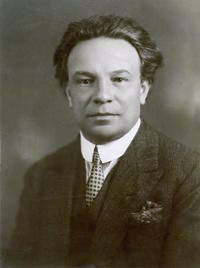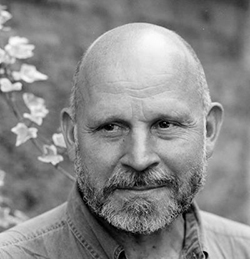
Guiding Lights
Words by Bernard Rofe.
Bernard Rofe is the Australian Chamber Orchestra's (ACO) librarian as well as a composer and arranger. Most recently his arrangement of Piazzolla’s Libertango was performed by Branford Marsalis and the ACO.
On the evening of 29 May 1913, audiences packed into Paris’s newly opened Théâtre des Champs-Élysées to witness an event that would have lasting effects on the future of classical music. That event, of course, was the first performance of Igor Stravinsky’s Rite of Spring, a work that seems as modern and futuristic today as it must have been to its first audience, which included such creative minds as Pablo Picasso, Claude Debussy and Marcel Proust.
Much is said of how “prophetic” and “influential” Stravinsky’s Rite is, but perhaps more than anything, The Rite is an homage to Stravinsky’s native roots and influences. Traditional Russian folk melodies dominate Stravinsky’s earliest major works, and are rendered using richly colourful yet innovative orchestrations. None of this was anything new: Stravinsky inherited these traits from his teacher Nikolai Rimsky-Korsakov, but he would take them to new, groundbreaking places.
Paying homage to one’s teachers and roots is a theme that permeates music history. We would not have the perfection of Mozart’s late quartets and symphonies if he wasn’t intently following in the footsteps of his friend Joseph Haydn, to whom he dedicated six of his late quartets. We would not have the turbulence of Beethoven’s Fifth Symphony if it wasn’t modelled on Mozart’s tragic 40th Symphony, and although Beethoven never fulfilled his wish to study with Mozart, he paid homage to the composer by writing several sets of variations on themes from Mozart’s operas. Without Gabriel Fauré’s influence, we would not have the distinctively French colour and sensuality of Ravel’s String Quartet, which is dedicated to his teacher.
More recently, an entire school of the 20th century’s most significant composers (including Aaron Copland, Elliot Carter, Philip Glass, Astor Piazzolla, Wojciech Kilar and Peggy Glanville-Hicks) owe not only their rigorously wrought composition skills but, most importantly, clarity and confidence in their individual styles, to the great composer and pedagogue Nadia Boulanger, such that she is one of the few great teachers in any art form that history has not forgotten.
History has a bad habit of forgetting some of its most important cornerstones. For much of the 19th century, and well into the early 20th century, the music of such seminal Renaissance and Baroque composers as Claudio Monteverdi, Antonio Vivaldi, Johann Sebastian Bach and their contemporaries was largely unknown to concertgoers: Vivaldi’s Four Seasons were far from the inescapable elevator music they seem today; Bach’s Goldberg Variations had not yet been recorded to international fame by Wanda Landowska or Glenn Gould. Indeed, much music from before Haydn’s time was largely restricted to academic study by specialist scholars.

One of these scholars was the Italian composer Ottorino Respighi, who counted among his teachers the composer and musicologist Luigi Torchi, an early music scholar who sowed the seeds for his lifelong interest in early music. This music, though fascinating to the young Respighi, was notoriously difficult to find at the best of times, and even when it could be found, it might be written in old fashioned notation that was difficult for the modern musician to interpret. Fortunately, a treasure trove of this music had recently become available in modern editions prepared by the Italian scholar Oscar Chilesotti, a pioneer in deciphering lute tablature. Chilesotti published several volumes of lute songs over a period of 30 years, and Respighi, fascinated by their contents, would turn to them several times between 1917 and 1932, arranging selected pieces for orchestra into his ever-popular Ancient Airs and Dances.
Listening to these works in 2019 can be a slightly disconcerting experience. Our ears are used to historically informed performances that use gut strings, harpsichord continuo and historical reproductions of lutes and theorbos. By comparison, Nadia Boulanger’s 1937 recordings of Monteverdi employed a grand piano which, at the time, would not have seemed out of place at all. And yet, for all their old Renaissance charm, Respighi’s arrangements have a romantic lyricism that makes them sound anything but ancient. Respighi paid homage to early music in numerous other works, notably Gli Ucelli (The Birds), such that his music and reputation are now inexplicably linked with his Italian roots.
Where Respighi paid homage to the musical influences of his native country, English composer Benjamin Britten paid homage to the man who gave him his musical influences. Frank Bridge was a notable figure in the British music scene of the early 20th century. A well-known composer, though something of an outsider in English music circles, Bridge was a part of the pastoral school of composers that included Arnold Bax and Frederick Delius – quite removed from the structured modernism that was taking over Europe at the time. In 1924, at the Norfolk and Norwich Festival, Britten first heard Frank Bridge’s orchestral poem The Sea. The effect was immediate: Britten “was knocked sideways”.
Britten returned to the Festival as a 13-year-old in 1927, finally meeting Bridge through his viola teacher, Audrey Alston. As they say, the rest is history: Britten became Bridge’s only composition student, taking day trips to visit Bridge’s London house. There, he took in all he could from Bridge’s principles of composition study: “One was that you should find yourself and be true to what you found. The other – obviously connected with the first – was his scrupulous attention to good technique, the business of saying clearly what was in one’s mind.” Bridge introduced Britten to a plethora of music, from the cornerstones of the classical canon to the beautifully modern music of Alban Berg and Arnold Schoenberg (with whom Britten briefly considered studying).
In 1937, the British conductor Boyd Neel sought to commission a new work for that year’s Salzburg Festival. His orchestra, which performed repertoire from Corelli to Stravinsky, would comprise “the best 18 string players in the country”. Britten completed the commission in a little over a month. He worked furiously but efficiently, selecting a simple theme from his teacher’s 1906 Three Idylls for string quartet, on which he produced a series of ten short variations – turning a daunting assignment into a manageable task. Endearingly, Britten decided that each variation should represent an aspect of his teacher’s personality, using musical styles and techniques that his teacher had so lovingly introduced him to. As well as the principal theme, Britten alluded to five other works by Bridge, including The Sea (the first piece by Brige that Britten ever heard), Enter Spring, Summer, There is a Willow Grows Aslant a Brook, and the Piano Trio.
The work launched Britten’s career, and he would go on to become the pre-eminent British composer of his day. But the real triumph of his Variations on a Theme of Frank Bridge, was that it ensured his teacher’s legacy would never be forgotten. Writing to Britten, Bridge said “It is one of the few lovely things that has ever happened to me, and I feel the richer in spirit for it all, including the charming dedication.” There is a touch of Elgarian self-pity in Bridge’s letter of thanks, acknowledging that, while Britten’s piece would keep his name alive, it was ultimately Britten who would gain immortality through his music.

While Britten’s Variations seem to strive for immortality, more than four decades later, Australia’s Richard Meale was grappling with mortality, dedicating Cantilena Pacifica to a friend who had recently passed away. Meale remains one of Australia’s most exceptional composers: a prominent advocate of new music by Boulez, Messiaen and Schoenberg, his own style evolved throughout the 20th century, embracing and mastering neo-Romanticism, serialism, atonalism and modernism, before rediscovering lyrical melody late in his career.
In the late 1970s, with much of his musical output firmly under the influence of European modernism and experimentalism, the most important stylistic change of Meale’s career would take place. A personal crisis had emerged: his adherence to the meticulously ordered neurotic convulsions of modernism was in direct conflict with his own honest artistic expression. This dilemma came to a head in 1979 as he was composing his second string quartet: “Sadly, my best friend, Stephen Wilson, died after a sudden onset of cancer. It now became a matter of necessity to write a piece that would be a memorial to him. So it became clear that the work could not be based on any artifice; its existence had to lie in its emotional truth.”
The quartet’s final movement, entitled Cantilena Pacifica, could not be more different from Meale’s previous output. Its lyrical violin line sings a mournful melody over a tonal undercurrent in the strings. In that same year Meale returned to a lushness of orchestration not seen since Debussy’s La Mer, re-embracing the emotional possibilities of harmony and tonality in his orchestral work Viridian. Meale’s newfound style would culminate in his 1986 opera Voss, an adaption of Patrick White’s novel of the same name, which would remain for many years the leading candidate for “the great Australian opera”.
On the other side of the world, Latvian composer Pēteris Vasks was having a similar crisis of faith. His earliest works owed much to the experimental music of Witold Lutosławski and Krzysztof Penderecki, as well as the music of Iron Curtain composer Dmitri Shostakovich. In his native Latvia, however, Vasks suffered under the repressions of Russian cultural doctrine due to his religious beliefs and artistic convictions. It is out of this political turbulence that his present style – which combines nationalistic, moral and environmental concerns – was born.

Today, Vasks’ music is often grouped with Europe’s holy minimalists: John Tavener, Henryk Górecki and of course, Arvo Pärt, another avant-gardist who experienced religious and artistic repression from the Soviets, and consequently turned to a deep spirituality in his music. Because of his emigration to Berlin in the early 1980s, Pärt’s music became widely known much sooner, such that his music and career became something of an inspiration to Vasks. In his 2001 composition Viatore, he pays homage to Pärt, whom he describes in the dedication as “my guiding light for many decades.”
In Viatore, Vasks pays tribute not only to Pärt’s intensely spiritual sound world, but to the very building blocks of his compositional technique, “tintinnabuli” (derived from the Latin word for “bell”), which sets one voice moving stepwise against a second voice moving in triads. In Vasks’s tribute, Pärt’s two voices become two musical images. One is a traveller who “arrives in this world, grows up in it, develops, falls in love, fills himself up and then departs”, the other is the “endless and starry universe” that illuminates his journey, in much the same way Pärt has illuminated Vasks’ journey for many years.
The works in this program are more than an eclectic assortment of fine, virtuosic music for string orchestra. As Lucretius observed, “the sum of things is ever being renewed … the generations, like runners, pass on the torch of life.” These works pay homage to each composer’s deepest influences and guiding lights, so as to create new music that illuminates the future.
Australian Chamber Orchestra performs Respighi, Britten & Vasks in Elisabeth Murdoch Hall on Tuesday 4 June. Click here to discover more.
You might also be interested in
-
Sonia Baldock has always found comfort in music.
-
Anna Goldsworthy contemplates the rich musical legacy of Richard Mills.
-

